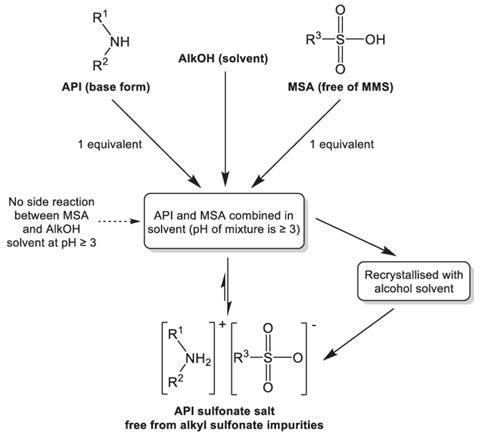A decade after concerns about the necessity of testing for alkyl sulfonate esters in drugs were raised1, risk assessment for this potentially mutagenic contaminant is still required by UK and European drug standard authorities.2 Other major standards bodies, such as the US and Japanese ones, do not have similar requirements for sulfonate-salt drugs.

In 2004, the European Pharmacopoeia of pharmaceutical standards introduced a requirement for sulfonate salt drug substances, stipulating that manufacturers must assess the possibility of alkyl sulfonate ester formation. ‘I was told back then that a French professor insisted that a side-reaction could occur during the synthesis of sulfonate salts using an alcohol solvent to produce alkyl-sulfonate impurities,’ says David Snodin, a UK pharmacotoxicology consultant who first highlighted concerns about the need for this testing.
Alkyl sulfonate esters are potentially mutagenic so there was concern about the possibility of this type of contamination arising when drugs containing sulfonate salts were produced.
In 2007, several batches of the HIV drug Viracept (nelfinavir), developed by Roche, were found to be contaminated with high levels of ethyl methanesulfonate. ‘Methane sulfonic acid was stored in a big tank. [Roche] used alcohol to clean the tank, but they didn’t get rid of the traces of alcohol, which reacted with the methane sulfonic acid when the tank was refilled,’ Snodin explains.
Despite the Viracept incident being explained by a cleaning error, it was used by regulatory bodies such as the European Directorate for the Quality of Medicines & HealthCare (EDQM), which publishes the European Pharmacopoeia, as further evidence that testing for alkyl sulfonate esters was needed.

Snodin maintains that this type of contamination is not possible under standard good manufacturing practice conditions and published an article earlier this year explaining why this type of contamination is extremely unlikely. Raphael Nudelman, a pharmaceutical chemical toxicology consultant based in Israel agrees. ‘The reaction conditions usually employed, which consists of addition of a stoichiometric amount of sulfonic acid to a basic drug in an alcohol solvent, never create the highly acidic environment necessary to convert alcohols into these esters,’ he says. ‘In such settings, all the acid is neutralised by the base drug, leaving no excess acidity to drive ester formation.’
Despite attempting to change practice and reaching out to regulatory bodies, Snodin says there has been no sign of any real change in the production statement requirements since 2015. ‘I do not consider the “production statement” requirements in the European and British Pharmacopoeia to be scientifically justified,’ says Nudelman. ‘Despite detailed, evidence-based appeals… both pharmacopoeias have maintained these requirements without providing mechanistic or empirical data to support them. This continued insistence appears to reflect a lack of proper scientific evaluation, rather than a justified exercise of regulatory caution.’
Nudelman adds that it is important to learn from incidents such as the Viracept contamination, but says safety regulations should be based on rigorous scientific evidence. ‘Overly cautious, unsupported measures can drain resources without improving safety.’
Legally, the requirement for this risk assessment comes under the aegis of the agency behind the official pharmacopoeia of the country or region in question, such as the EDQM, but regulatory agencies involved in granting drug marketing approval can also influence this.
When asked about this issue, the US Food and Drug Administration and the UK’s Medicines and Healthcare products Regulatory Agency declined to comment. However, a spokesperson from the European Medicines Agency (EMA) said: ‘The EMA’s quality working party holds an “interested parties” meeting on an annual basis where industry stakeholders are free to suggest topics for discussion.’
‘At no point in the last 10 years has this topic been suggested for the agenda. Industry is welcome to suggest the topic at a future interested parties meeting for discussion if they so wish.’
References
1 D Snodin and A Teasdale, Org. Process Res. Dev., 2015, DOI: 10.1021/op500397h
2 D Snodin, J. Pharm. Sci., 2025, DOI: 10.1016/j.xphs.2024.11.002





No comments yet